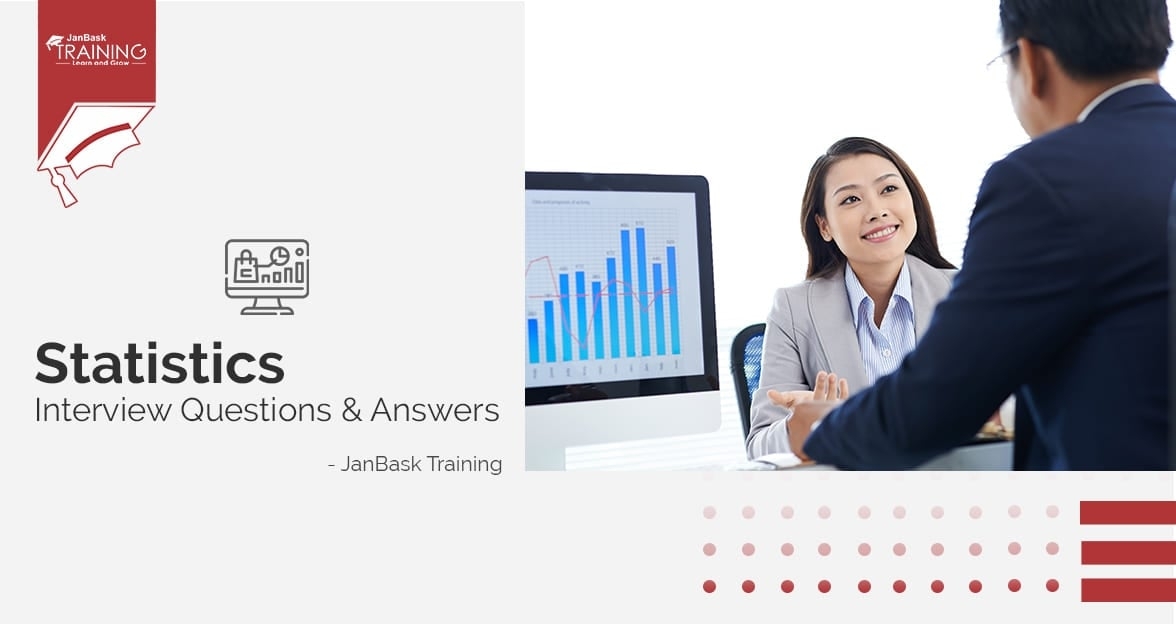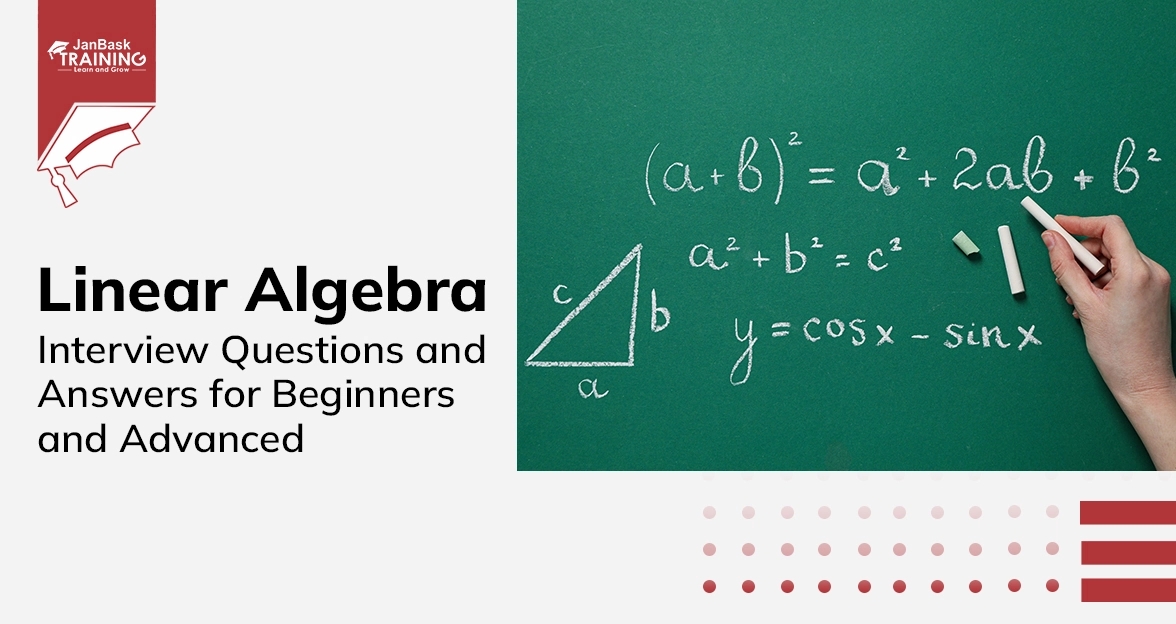 Grab Deal : Upto 30% off on live classes + 2 free self-paced courses - SCHEDULE CALL
Grab Deal : Upto 30% off on live classes + 2 free self-paced courses - SCHEDULE CALL

 Grab Deal : Upto 30% off on live classes + 2 free self-paced courses - SCHEDULE CALL
Grab Deal : Upto 30% off on live classes + 2 free self-paced courses - SCHEDULE CALL

Probability and statistics is a building block in data science and understanding these can help data science professionals build models and find important information. To help you do well in your data science interviews, we've compiled a list of important advanced-level probability and statistics interview questions and answers that will equip you to solve real-world problems effectively and succeed in data science interviews.
A: Standard deviation explains us how spread out the data points are from the mean which means the data points are close to the averageIf the standard deviation is low. If it's high, it means the data points are spread out far from the average.
A: TF/IDF stands for Term Frequency – Inverse Document Frequency which is a way to measure the importance of a word in a document as compared to a whole collection of other documents. In simple words The more a word appears in a document (Term Frequency), and the less it appears in other documents (Inverse Document Frequency), the higher its TF/IDF value.
A: Descriptive statistics describe various features and distribution of a dataset, such features include average, median, variance, etc which helps us understand the data using tables and visualizations like histograms.
Inferential statistics help us make inferences and predictions about a larger population based on a sample. This involves hypothesis testing and using techniques like confidence intervals to estimate population parameters.
A: Central tendency measures help us understand where the center of a dataset lies. There are three main measures:
Mean: The average of all data points.
Median: The middle value of a dataset. If there's an even number of data points, it's the average of the two middle values.
A: Probability Distribution: It's a function that tells us the likelihood of a random variable taking different values. There are two main types: discrete (like binomial and Poisson) and continuous (like normal and uniform).
Sampling Distribution: It's the probability distribution of a statistic based on different random samples from a population. For example, if you're studying patients with Alzheimer’s, you might use sampling distribution to understand patterns in the data.
A: Hypothesis testing helps us assess ideas about a population based on sample data. We start with a null hypothesis (H0) that assumes no difference or relationship between variables. Then, we have an alternative hypothesis that considers the opposite. If the data suggests the null hypothesis is unlikely, we reject it in favor of the alternative.
We choose a statistical test based on the hypothesis we're testing. If the probability of the null hypothesis (p-value) is below a certain significance level (like 0.05), we reject the null hypothesis.
A: Correlation measures the linear relationship between two or more variables, while autocorrelation measures the linear relationship between two values of the same variable. Correlation ranges between -1 and 1, indicating the strength and direction of the relationship. Autocorrelation, like correlation, can be positive or negative, but it specifically examines how a variable correlates with itself across different time periods, commonly used in time series analysis.
A: The normal distribution, also known as the Gaussian distribution, is a fundamental concept in statistics. It is characterized by a symmetrical bell-shaped curve, with the majority of the data clustered around the mean. In a normal distribution, the mean and median are equal, typically at zero, and the standard deviation measures the spread of the data. The empirical rule, also known as the 68-95-99.7 rule, states that approximately 68% of the data falls within one standard deviation of the mean, 95% within two standard deviations, and 99.7% within three standard deviations, making it a useful tool for understanding the distribution of data in various contexts.
A: The p-value shows the probability of getting certain results if the null hypothesis is true. If the p-value is lower than a significance level (like 0.05), we reject the null hypothesis. This indicates that the results are statistically significant, meaning they're unlikely to have occurred by chance. Understanding p-values is crucial in data analysis and often comes up in statistics interviews.
A: Probability and statistics are related areas of mathematics that concern themselves with analyzing the relative frequency of events. Still, there are fundamental differences in the way they see the world:
Probability deals with predicting the likelihood of future events, while statistics involves analyzing the frequency of past events.
Probability is primarily a theoretical branch of mathematics that studies the consequences of mathematical definitions. Statistics is primarily an applied branch of mathematics that tries to make sense of observations in the real world.
Both subjects are meaningful, relevant, and valuable. However, they are different, and understanding the distinction is crucial in properly interpreting the relevance of mathematical evidence.
A: Descriptive statistics capture the properties of a given data set or sample. They summarize observed data and provide a language for discussing it. Representing a group of elements by a newly derived element, like mean, min, count, or sum, reduces an extensive data set to a small summary statistic: aggregation as data reduction.
Such statistics can become features in their own right when taken over natural groups or clusters in the complete data set. There are two main types of descriptive statistics:
Central tendency measures capture the center around which the data is distributed.
Variation or variability measures describe the data spread, i.e., how far the measurements lie from the center.
Together, these statistics tell us an enormous amount about our distribution.
A: The mode is the most frequent element in the data set. This is 7 in dice as an example because it occurs six times out of thirty-six elements. I've never seen the mode provide much insight as a centrality measure because it often isn't close to the center.
Samples measured over an extensive range should have few repeated elements or collisions at any particular value. This makes the mode a matter of luck. Indeed, the most frequently occurring elements reveal artifacts or anomalies in a data set, such as default values or error codes that do not represent elements of the underlying distribution.
A: To calculate the probability of rolling at least one five with two dice, we can first find the probability of each die not rolling a five and then subtract that from 1, as the probability of not rolling a five represents the complement of rolling at least one five.
Probability of rolling a five on one die = 1/6
Probability of not rolling a five on one die = 1 - 1/6 = 5/6
Since the outcomes of rolling each die are independent, we can use the multiplication rule for independent events:
P(A∩B) = P(A) * P(B)
Where A represents rolling a five on the first die and B represents rolling a five on the second die.
P(A∩B) = (1/6) * (1/6) = 1/36
Now, we can use the formula for the probability of the union of two events:
P(A∪B) = P(A) + P(B) - P(A∩B)
P(A∪B) = (1/6) + (1/6) - (1/36) = 11/36
Therefore, the probability of rolling at least one five with two dice is 11/36.
A: To find the probability of drawing two cards with the same suit from the same deck, we consider the first card drawn and then calculate the probability of drawing a second card with the same suit, given the outcome of the first draw.
Probability of drawing a card from a certain suit on the first draw = 13/52 (since there are 13 cards of each suit in a standard deck of 52 cards).
After drawing the first card, there are now 51 cards left in the deck, and 12 of them are from the same suit as the first card drawn.
Therefore, the probability of drawing a second card of the same suit = 12/51.
Since there are four suits in a standard deck, we multiply the probability of drawing two cards of the same suit by 4:
P(two cards same suit) = 4 * (13/52) * (12/51) = 4/17.
A: The geometric mean is the nth root of the product of n values:
The geometric mean is always less than or equal to the arithmetic mean. For example, the geometric mean of the sums of 36 dice rolls is 6.5201, as opposed to the arithmetic mean of 7. It is susceptible to values near zero. A single value of zero lays waste to the geometric mean: no matter what other values you have in your data, you end up with zero. This is somewhat analogous to having an outlier of ∞ an arithmetic mean.
However, geometric means prove their worth when averaging ratios. The geometric mean of 1/2 and 2/1 is 1, whereas the mean is 1.25. There is less available "room" for ratios to be less than one than for ratios above 1, creating an asymmetry that the arithmetic mean overstates. The geometric mean is more meaningful in these cases, as is the arithmetic mean of the logarithms of the ratios.
A: Suppose we are given two variables, x and y, represented by a sample of n points of the form (xi, yi), for 1 ≤ i ≤ n. We say that x and y are correlated when the value of x has some predictive power on the value of y.
The correlation coefficient r(X, Y ) is a statistic that measures the degree to which Y is a function of X and vice versa. The value of the correlation coefficient ranges from −1 to 1, where one means fully correlated, and 0 implies no relation or independent variables. Negative correlations imply that the variables are anti-correlated, meaning that when X goes up, Y goes down.
Ideally, anti-correlated variables correlate −1. Note that negative correlations are just as good for predictive purposes as positive ones. That you are less likely to be unemployed if you have more education is an example of a negative correlation, so the education level can help predict job status. Correlations around 0 are useless for forecasting.
A: Some examples of observed correlations driving predictive models in data science include:
Are taller people more likely to remain lean? Yes, the observed correlation between height and BMI is r = -0.711, indicating a negative correlation, suggesting that taller individuals tend to have lower body mass index (BMI).
Do standardized tests predict college performance? Yes, there is some degree of predictive power, as the observed correlation between SAT scores and freshmen GPA is r = 0.47. However, it's noteworthy that socioeconomic status shows a similar correlation with SAT scores (r = 0.42).
Does financial status affect health? Yes, there is a strong negative correlation between household income and the prevalence of coronary artery disease, with an observed correlation of r = -0.717. Therefore, individuals with higher income levels tend to have a lower risk of heart attack.
Does smoking affect health? Yes, the observed correlation between a group's propensity to smoke and their mortality rate is r = 0.716, indicating a significant correlation. Thus, smoking has adverse effects on health, emphasizing the importance of avoiding it.
Do violent video games increase aggressive behavior? Yes, there is a weak but significant correlation between playing violent video games and aggressive behavior, with an observed correlation of r = 0.19. This suggests that while the correlation exists, its strength is weaker than other correlations discussed.
A: The Pearson correlation coefficient defines the degree to which a linear predictor of the form y = m·x+b can fit the observed data. This generally does an excellent job of measuring the similarity between the variables. Still, it is possible to construct pathological examples where the correlation coefficient between X and Y is zero, yet Y depends entirely on (and hence perfectly predictable from) X.
Consider points of the form (x, |x|), where x is uniformly (or symmetrically) sampled from the interval [−1, 1]. The correlation will be zero because there will be an offsetting point (x, x) for every point (−x, x), yet y = |x| is a perfect predictor. Pearson correlation measures how well the best linear predictors can work but says nothing about weirder functions like absolute value.
The Spearman rank correlation coefficient essentially counts the number of pairs of out-of-order input points. Suppose that our data set contains points (x1, y1) and (x2, y2) where x1 < x2>This is a vote that the values are positively correlated, whereas the vote would be for a negative correlation if y2 < y1>
Summing up all pairs of points and normalizing properly gives us Spearman rank correlation.
A: The strength of correlation, as indicated by the coefficient of determination R^2, quantifies the proportion of variance in the dependent variable (Y) explained by the independent variable (X) in a simple linear regression model. For instance, a correlation coefficient of approximately 0.8 implies an R^2 of about 0.64, meaning it explains roughly two-thirds of the variance in the data.
However, it's crucial to recognize that the predictive power of a correlation diminishes rapidly as its strength decreases. For example, a correlation of 0.5 possesses only 25% of the maximum predictive power, while a correlation of 0.1 only holds a 1% predictive value. Therefore, while establishing weak correlations may be interesting, it's essential to be cautious about overestimating their predictive utility in data science analyses.
A: In data science, we often develop and assess multiple models for predictive tasks, which can vary in complexity and performance. While it may be tempting to favor the model with the highest accuracy on the training data, slight differences in performance are often due to chance rather than genuine predictive ability.
This variability can stem from factors such as the choice of training and evaluation sets or how healthy parameters are optimized. When faced with models exhibiting similar performance, it's important to remember that simpler models may be preferable over more complex ones. This preference for simplicity acknowledges that slight performance differences between models may not necessarily indicate superior predictive power but rather reflect random variation.
Analogously, in scenarios like predicting coin toss outcomes, individuals may achieve differing levels of success, but selecting the person with the most correct predictions doesn't inherently signify more excellent predictive capability. Therefore, in the practice of data science, prioritizing simpler models over more complex ones can help mitigate the risk of overfitting and enhance model interpretability without sacrificing predictive accuracy.
A: The median represents the middle value in a dataset, with an equal number of elements lying above and below it. In cases of an even number of elements, one can choose either of the two central values. Notably, the median retains a fundamental property by being an actual value within the original dataset, unlike the average of the two central elements.
While the median typically aligns closely with the arithmetic mean in symmetric distributions, comparing the two can reveal insights into distribution shape and centrality. However, the median often outperforms the mean in skewed distributions or datasets containing outliers, such as those found in wealth and income data.
For instance, in the United States, Bill Gates significantly inflates the mean per capita wealth but does not affect the median. Thus, the median proves to be a more informative statistic in such scenarios, particularly in power law distributions.
Data Science Training - Using R and Python

JanBask Training's Data Science courses can complement your learning journey in probability and statistics by providing specialized knowledge and skills for your data science interview. JanBask Traning's data science courses provide structured learning paths, expert guidance, and hands-on experience, making it easier for professionals to acquire and apply mathematical preliminaries effectively in real-world scenarios, thus enhancing their readiness to ace data science interviews.

Statistics Interview Question and Answers


Data Warehouse Interview Question And Answers in 2024

Cyber Security

QA

Salesforce

Business Analyst

MS SQL Server

Data Science

DevOps

Hadoop

Python

Artificial Intelligence

Machine Learning

Tableau
Download Syllabus
Get Complete Course Syllabus
Enroll For Demo Class
It will take less than a minute
Tutorials
Interviews
You must be logged in to post a comment